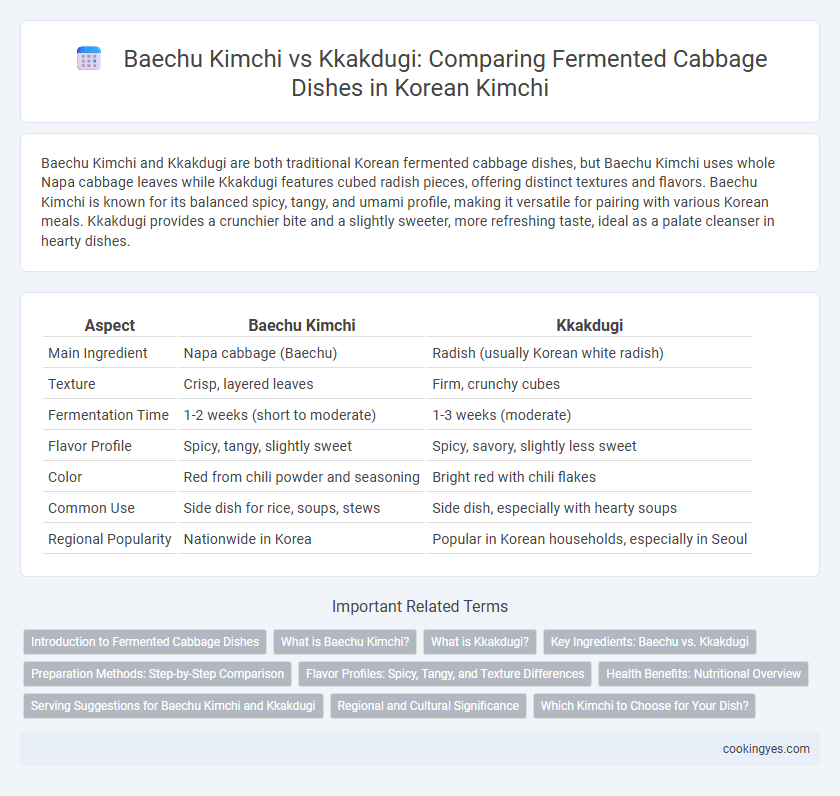Baechu Kimchi and Kkakdugi are both traditional Korean fermented cabbage dishes, but Baechu Kimchi uses whole Napa cabbage leaves while Kkakdugi features cubed radish pieces, offering distinct textures and flavors. Baechu Kimchi is known for its balanced spicy, tangy, and umami profile, making it versatile for pairing with various Korean meals. Kkakdugi provides a crunchier bite and a slightly sweeter, more refreshing taste, ideal as a palate cleanser in hearty dishes.
Table of Comparison
| Aspect | Baechu Kimchi | Kkakdugi |
|---|---|---|
| Main Ingredient | Napa cabbage (Baechu) | Radish (usually Korean white radish) |
| Texture | Crisp, layered leaves | Firm, crunchy cubes |
| Fermentation Time | 1-2 weeks (short to moderate) | 1-3 weeks (moderate) |
| Flavor Profile | Spicy, tangy, slightly sweet | Spicy, savory, slightly less sweet |
| Color | Red from chili powder and seasoning | Bright red with chili flakes |
| Common Use | Side dish for rice, soups, stews | Side dish, especially with hearty soups |
| Regional Popularity | Nationwide in Korea | Popular in Korean households, especially in Seoul |
Introduction to Fermented Cabbage Dishes
Baechu Kimchi and Kkakdugi are two iconic Korean fermented cabbage dishes known for their distinct preparation methods and flavor profiles. Baechu Kimchi utilizes whole Napa cabbage leaves seasoned with a spicy, tangy mixture of chili flakes, garlic, and ginger, resulting in a robust, complex taste. Kkakdugi, made from diced radish rather than cabbage, offers a crunchier texture and a milder fermentation, distinguishing it within the diverse world of fermented Korean side dishes.
What is Baechu Kimchi?
Baechu Kimchi is a traditional Korean fermented vegetable dish primarily made with napa cabbage, seasoned with chili pepper flakes, garlic, ginger, and fish sauce, which imparts a spicy, tangy flavor. Unlike Kkakdugi, which uses cubed radishes as its main ingredient, Baechu Kimchi centers on the layered textures of whole cabbage leaves that absorb the rich fermentation brine over time. This staple kimchi variety is rich in probiotics and vitamins, contributing to digestive health and adding depth to Korean cuisine.
What is Kkakdugi?
Kkakdugi is a traditional Korean fermented side dish made from cubed radish rather than napa cabbage, distinct from Baechu Kimchi's use of whole napa cabbage leaves. The radish pieces are typically coated in a spicy mixture of Korean red pepper flakes (gochugaru), garlic, ginger, and salted shrimp, which promotes fermentation resulting in a crunchy texture and tangy flavor. Known for its refreshing crunch and rich probiotic benefits, Kkakdugi is a popular accompaniment to hearty Korean dishes like soups and stews.
Key Ingredients: Baechu vs. Kkakdugi
Baechu Kimchi primarily uses whole Napa cabbage leaves, which are salted and fermented with a spicy mixture of Korean chili flakes, garlic, ginger, and fish sauce, delivering a layered texture and bold umami flavor. In contrast, Kkakdugi features diced Korean radish fermented with similar seasonings but emphasizes a crunchy bite and refreshing taste due to the radish's natural water content. Both varieties harness the power of fermentation for probiotics but differ in texture and flavor profiles because of their core ingredients: cabbage versus radish.
Preparation Methods: Step-by-Step Comparison
Baechu kimchi involves salting whole Napa cabbage leaves to soften them before applying a spicy red pepper paste mixed with garlic, ginger, and seafood-based ingredients, ensuring deep fermentation flavors. Kkakdugi preparation starts with peeling and cubing Korean radish, then coating the pieces with a similar spicy seasoning paste, but the texture and fermentation environment differ due to the vegetable's firmness. Both require an initial salting or brining phase to draw out moisture, promoting optimal fermentation while developing distinct taste profiles shaped by texture and ingredient composition.
Flavor Profiles: Spicy, Tangy, and Texture Differences
Baechu kimchi offers a complex balance of spicy and tangy flavors with a crunchy yet slightly soft texture due to its fermentation of whole napa cabbage leaves, enhancing umami depth. Kkakdugi, made from diced radish, presents a sharper, more pungent tang with a crisp, firm texture that intensifies the refreshing bite alongside its spicy kick. The distinct texture contrast between the tender baechu and the crunchy kkakdugi reflects their unique fermentation processes and ingredient structures, shaping their flavor profiles.
Health Benefits: Nutritional Overview
Baechu kimchi, made from napa cabbage, is rich in vitamins A, C, and K, as well as probiotics that support gut health and strengthen the immune system. Kkakdugi, a fermented radish dish, provides a higher fiber content and antioxidants that promote digestion and reduce inflammation. Both varieties deliver essential nutrients and beneficial bacteria that contribute to improved metabolism and overall wellness.
Serving Suggestions for Baechu Kimchi and Kkakdugi
Baechu Kimchi pairs excellently with grilled meats, rice bowls, and Korean stews, enhancing savory dishes with its spicy, tangy flavor and crunchy texture. Kkakdugi, made from cubed radish, serves as a refreshing side that complements rich soups like seolleongtang and yukgaejang by adding a crisp, mildly sweet contrast. Both kimchi varieties are essential for balancing traditional Korean meals with their unique fermented profiles.
Regional and Cultural Significance
Baechu Kimchi, made from whole napa cabbage, is widely consumed across Korea, symbolizing traditional Korean dining, particularly in regions like Seoul and Gyeongsang Province where it accompanies most meals. Kkakdugi, diced radish kimchi, holds cultural significance in the southern provinces such as Jeolla and is often paired with hearty stews like galbi-tang, reflecting regional palate preferences. Both varieties showcase Korea's diverse fermentation techniques, embodying the cultural identity and agricultural practices unique to their respective regions.
Which Kimchi to Choose for Your Dish?
Baechu Kimchi, made from whole napa cabbage leaves, offers a tangy, spicy flavor with a crunchy texture that pairs well with Korean BBQ and soups. Kkakdugi, featuring cubed radish rather than cabbage, provides a crisp, refreshing bite ideal for stews and rice dishes. Choose Baechu Kimchi for versatility and boldness, while Kkakdugi suits meals needing a milder, crunchy complement.
Baechu Kimchi vs Kkakdugi for fermented cabbage dishes Infographic

 cookingyes.com
cookingyes.com